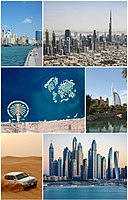
Photo from wikipedia
Stalagmites provide one of the few high-quality proxy records of the Thailand monsoon. The Namjang (NJ) cave (19°40′30″N, 98°12′12″E; 923 m a.s.l.), which is situated in the data-scarce region of… Click to show full abstract
Stalagmites provide one of the few high-quality proxy records of the Thailand monsoon. The Namjang (NJ) cave (19°40′30″N, 98°12′12″E; 923 m a.s.l.), which is situated in the data-scarce region of northwestern Thailand, serves as a unique and important site that offers great potential for multi-proxy climate reconstruction. We present new data on stable oxygen isotopic (δ 18 O) compositions and growth rates of aragonite stalagmites based on an in situ cave and climate monitoring study performed between August 2012 and October 2013. The dominant factors that control the variations in the δ 18 O values of rainfall, drip water, and modern aragonite precipitate as well as the variations in the modern speleothem deposition rates and drip water hydrochemical properties were determined to correctly interpret the climatic signals of the parameters that are derived from speleothems. The intraseasonal variations in rainfall δ 18 O values were faithfully recorded from cave drip water isotopic signals. The monthly mean values of δ 18 O in cave drip water were lower in the rainy season and higher in the dry seasons and shifted from approximately − 4 in the early rainy months to approximately − 6‰ in the late rainy months. These variations have implications for the use of speleothem δ 18 O from the NJ cave as a proxy of the seasonal variations in monsoon rainfall δ 18 O and changes in moisture source trajectories. The deposition rates of modern speleothem deposits are primarily controlled by drip water flow rates, which are linked to the amount of water recharge in the cave during the summer monsoon season. There was a significant correlation between the drip rate and amount of carbonate precipitation for the drip sites NJ-1 ( r = 0.54, p < 0.040) and NJ-1202 ( r = 0.76, p < 0.004). Combinations of different parameters and proxies from this area could provide the potential for the further development of multi-proxy climate reconstructions over different time scales.
Journal Title: Theoretical and Applied Climatology
Year Published: 2020
Link to full text (if available)
Share on Social Media: Sign Up to like & get
recommendations!